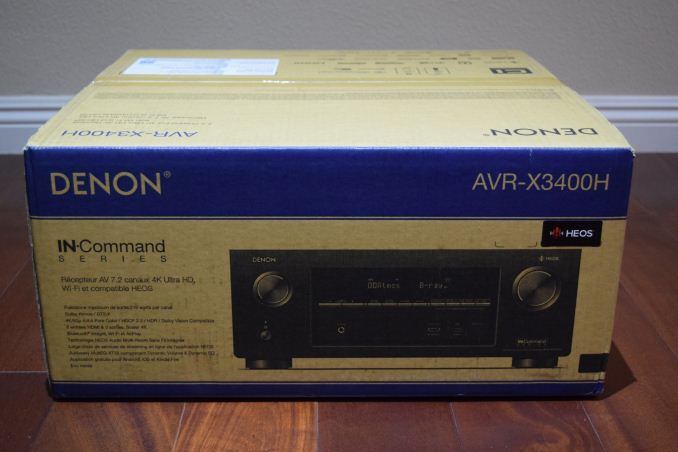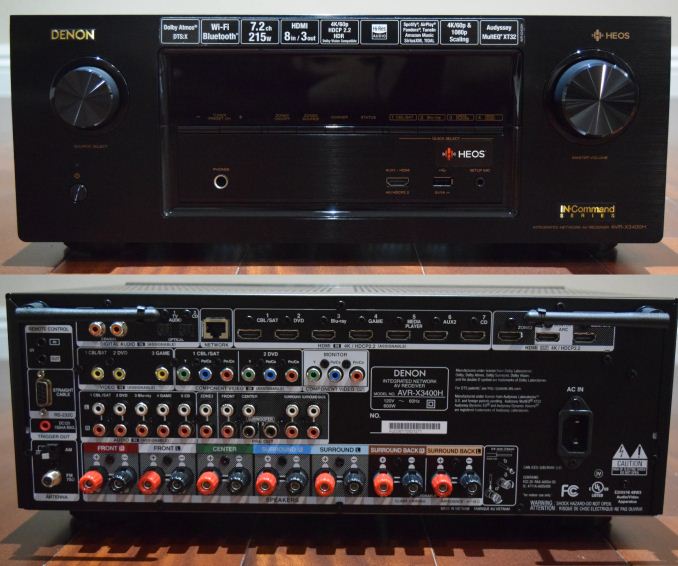A Budget Home Theater & PC Setup: 4K, HDR, UHD Blu-ray, and More
by Ganesh T S on December 26, 2017 8:30 AM ESTThe AVR: Denon X3400H
The choice of AVRs used to be a difficult one to make when support for different HD audio formats was not widespread. Now, the requirements boil down to the AVR being able to support the latest HD audio formats (Dolby Atmos and DTS-X), while matching the capabilities of the display in the chain. The additional features may help sway the purchase decision for consumers.
Budget considerations dictate the number of channels and display zones. We had to migrate from the 7.1 channel Pioneer Elite VSX-32 to a newer receiver capable of handling multiple HDMI 2.0 / HDCP 2.2 inputs with passthrough capabilities for various HDR formats. Based on my budget, I narrowed down the options to one of the models from Denon, Onkyo, Pioneer, and Yamaha. They are all in the same ball park in terms of pricing for a given feature set. We deferred to our friends at Wirecutter, who recommended the Denon AVR S730H.
I had been in touch with Denon regarding HEOS (their whole home audio solution) when the decision to go with a Denon AVR for our HTPC testing setup was taken. Upon discussing our project with them, Denon graciously agreed to sponsor the more advanced AVR X3400H for use in our testing.
The AVR X3400H targets the custom integrator channel. It has a number of additional features such as support for high end DSD audio, 4Kp60 upconversion for analog sources, multi-zone video outputs, higher power output, and support for eARC (Enhanced Audio Return Channel) to justify its higher price over the S730H. The presence of eARC makes it a bit more future-proof, as it allows for HD audio (including the new ones like Dolby Atmos and DTS-X) from the display sink to be returned to the AVR for decode and playback.
In the course of our testing, we found that the AVR received frequent firmware updates to add new features such as HLG passthrough. These point to a well-supported product. Even though the web control feature present in the previous generation Denon AVRs was missed, the Denon AVR Android app made up for it to some extent. None of the issues encountered in the course of the evaluation presented in this piece could be attributed to the Denon AVR X3400H.
If we had to give some suggestions to Denon for the improvement of the AVR X3400H, it would be to bring back the web control feature and shorten the time taken for firmware updates (though there is a facility to enable auto-updates that tries to install the new firmware when the AVR is not being used).
Speakers
Most readers upgrading their HTPC can opt to retain their existing speakers. In fact, I had the Boston Acoustics Horizon Series MCS100MDNT 5.1-channel speaker system from a 2008 purchase, along with a Jamo A306 HCS 5.1 speaker system from my 2011 home theater components upgrade. However, due to the remodel, I had to go in for in-ceiling speakers. I opted for a couple of the Polk Audio RC80i in-ceiling pairs for the rear and surround channel speakers. I bundled them along with ceiling speaker protective covers. The choice of speakers depends on the home theater size and other requirements. Currently, I am using the Jamo A306 speakers for the front, center, and subwoofer, with the Polk Audio RC80i for the other channels.












191 Comments
View All Comments
rapster - Sunday, December 31, 2017 - link
Definitely. My media cabinet alone was $3k and is the budget option compared to the built-in at my last house. I really don’t get the budget complaints unless we’re dealing with kids, and thought the piece addressed quite a few things that caused me grief. Wish I read it before my last build.ganeshts - Tuesday, December 26, 2017 - link
Most speakers were re-used from my previous setup, and as such, not a part of the initial purchase list. I assume most users who upgrade can reuse existing speakers. I provided a suggestion in the concluding section.NeatOman - Tuesday, December 26, 2017 - link
I'm still content with my current setup of a plasma connected via HDMI 4:4:4 and true 8-bit to a Pentium G6950/H57/4GB w/60GB SSD that's as quiet as a cat fart. The sound IMO hasn't improved much at all unless you are going full ATMOS, my 10+ year old setup is "limited" by 5.1 96k/24-bit audio :-/ (limited by the human ear as well lol) and the speakers (that cost under a few hundred dollars) haven't really gotten any better in the last 10+ years despite what people claim (marginal at best).Plasma still has better colors than the newest quantum/nando/hyper whatever LCD/LED TV's, although due to light/color bleed either from the panel itself or just having the lights on it's blacks aren't as good on my 6+ year old Plasma. And since i only use it for movies there still isn't any noticable burn in.
But I'm definitely going to replace the PC with something Intel powered that can handle HDR10 and 4K streaming (DRM) that i believe is anything iX-7xxx and up when i get a proper OLED TV.
beisat - Tuesday, December 26, 2017 - link
Netflix on PC is never 24p - neither on Edge nor UWP App...just keep that in mind if you ever consider using a htpc on a tv...Orange14 - Tuesday, December 26, 2017 - link
I agree with others as to some of these setups not qualifying as budget HTPCs. In addition, the major fault is to assume that nobody runs cablecard tuners anymore. In my case, I still watch a fair amount of sports that requires such a set up. I've been building my own HTPCs for over five years now in a variety of different configurations. Unless one really needs the setup for gaming, the hardware requirements are modest.euskalzabe - Tuesday, December 26, 2017 - link
I'm so surprised to not even see a mention of Windows 10's horrendous HDR support. I use a HDR10 supporting TV as a monitor, with a GTX 1060, and the second I enable HDR on the desktop everything looks awfully washed out. Many have commented on this problem online forums. Sadly HDR on Windows 10 is, currently, unusable.Aikouka - Wednesday, December 27, 2017 - link
If you enable HDR in the resolution options in Windows, it will leave HDR on *at all times*. The problem is that it makes *no attempts* to adjust the content. So, it will effectively display SDR content in HDR, which doesn't turn out well. Although, I didn't notice nearly as many issues on my Sony TV as I did on my TCL TV (the Best Buy variant of the one in the this article, the P605). I wonder if that's due to the Sony TV's features including adjusting SDR content to try to make it look more like HDR?reiggin - Tuesday, December 26, 2017 - link
Not to pile on for the sake of piling on, but as others have said, this article just doesn't meet the stated objective of the headline. It's not a budget setup. It actually fails on two points -- it's neither "budget" nor "setup." To imply that it is a setup would imply that it's fully baked out. It's missing several crucial pieces of info on the speakers/audio quality (only noting the receiver and a set of surrounds is missing so much detail). And it's also missing basic details on how the whole system is configured, intended use, impressions other than technical ones, etc.All in all, this article really disappoints. It's subpar on the quality I've come to expect from Anandtech. There are glaring typos throughout that should be caught with a basic spell check. The structure of the article itself seems to bounce around. Heck, even the introductory first page just seems to be a hot mess.
I think in the end the best (admittedly unsolicited) advice that I could give is to just leave the home theater reviews to AVSForums or some other more experienced site and instead stick to reviews of individual hardware components.
Chyll2 - Tuesday, December 26, 2017 - link
Subpar article. I rather see this in a personal blog not in this site. One of the worst "budget" article I saw in a whilemr_tawan - Tuesday, December 26, 2017 - link
On the HTPC front, I guess you went for Core i5 HTPC just for SGX that's required by PowerDVD. It looks like all 7th gen Core CPU supports SGX (unlike Skylake which the lower bound is Core i5), so maybe Core i3 NUC works as well in this regard?